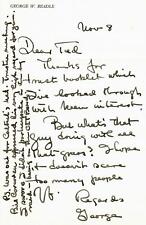"Nobel Prize in Physics" Roy J. Glauber Signed Announcement For Sale

When you click on links to various merchants on this site and make a purchase, this can result in this site earning a commission. Affiliate programs and affiliations include, but are not limited to, the eBay Partner Network.
"Nobel Prize in Physics" Roy J. Glauber Signed Announcement:
$499.99
Up for sale a RARE! "Nobel Prize in Physics" Roy J. Glauber Hand Signed Announcement dated 1988.
ES-4540E
Roy Jay Glauber (September 1, 1925 – December 26, 2018) was an American theoretical physicist. He was University and Adjunct Professor of Optical Sciences at the University of Arizona. Born in New York City, he was awarded one half of the 2005 Nobel Prize in Physics "for his contribution to the quantum theory of optical coherence", with the other half shared by John L. Hall and Theodor W. Hänsch. In this work, published in 1963, he created a model for photodetection and explained the fundamental characteristics of different types of light, such as laser light (see coherent state) and light from light bulbs (see blackbody). His theories are widely used in the field of quantum optics.In statistical physics he pioneered the study of the dynamics of first-order phase transitions, since he first defined and investigated the stochastic dynamics of a Ising model in a largely influential paper published in 1963. He served on the National Advisory Board[8] of the Center for Arms Control and Non-Proliferation, the research arms of Council for a Livable World. Glauber was born in 1925 in New York City, the son of Felicia (Fox) and Emanuel B. Glauber. He was a member of the 1941 graduating class of the Bronx High School of Science, the first graduating class from that school. He then went on to do his undergraduate work at Harvard University. After his sophomore year he was recruited to work on the Manhattan Project, where (at the age of 18) he was one of the youngest scientists at Los Alamos National Laboratory. His work involved calculating the critical mass for the atom bomb. After two years at Los Alamos, he returned to Harvard, receiving his bachelor's degree in 1946 and his PhD in 1949. Glauber's recent research dealt with problems in a number of areas of quantum optics, a field which, broadly speaking, studies the quantum electrodynamical interactions of light and matter. He also continued work on several topics in high-energy collision theory, including the analysis of hadron collisions, and the statistical correlation of particles produced in high-energy reactions. Specific topics of his research included: the quantum mechanical behavior of trapped wave packets; interactions of light with trapped ions; atom counting-the statistical properties of free atom beams and their measurement; algebraic methods for dealing with fermion statistics; coherence and correlations of bosonic atoms near the Bose–Einstein condensation; the theory of continuously monitored photon counting-and its reaction on quantum sources; the fundamental nature of "quantum jumps"; resonant transport of particles produced multiply in high-energy collisions; the multiple diffraction model of proton-proton and proton-antiproton scattering.

Related Items:
"Nobel Prize in Physics" Alexei Abrikosov Signed 2X3.25 Card JG Autographs
$69.99
"Nobel Prize in Medicine" E Donnall Thomas Hand Written Letter COA
$279.99
“Nobel Prize in Medicine" George Beadle Hand Written Letter COA
$174.99



